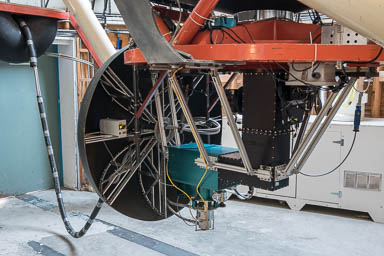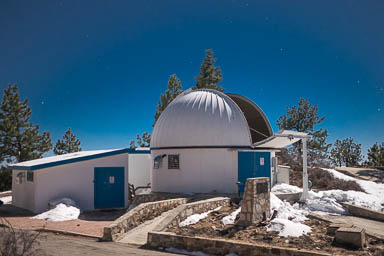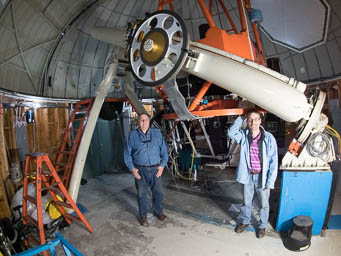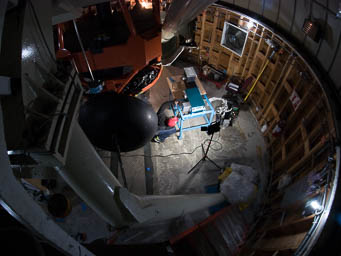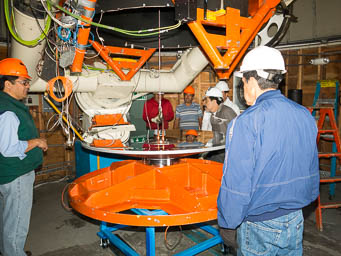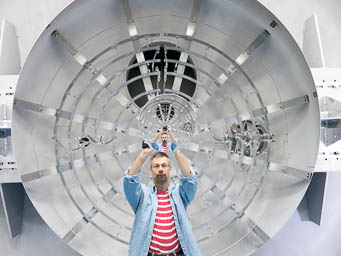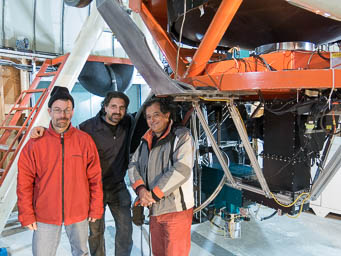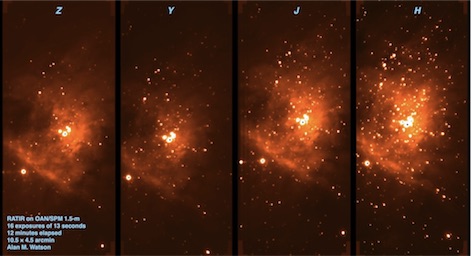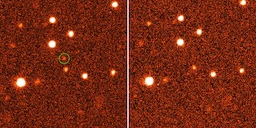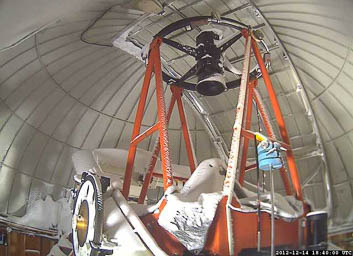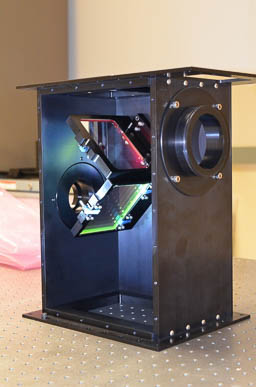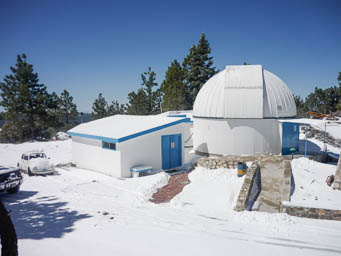These works are licensed under a Creative Commons Attribution-ShareAlike 4.0 International License.
The RATIR instrument mounted on the telescope. The black L-shaped structure supports the two CCD detectors (C0 and C1) and the ambient-temperature reimaging optics for the infrared channels. The blue box is the cryostat that holds the two infrared detectors (C2 and C3). The black “donut” on north (left) side of the telescope prevents the compressed helium hoses from snagging on the telescope.
- Full Resolution
- Copyright (c) 2016 Alan M. Watson
The Harold L. Johnson telescope at night.
- Full Resolution
- Copyright (c) 2016 Alan M. Watson
Leroy Sparr (left) and Alan Watson (right) after reinstalling the cryostat and re-imaging optics after maintenance.
- Full Resolution
- Copyright (c) 2016 Alan M. Watson
Ori Fox reinstalling the cryostat and re-imaging optics after maintenance.
- Full Resolution
- Copyright (c) 2016 Alan M. Watson
Staff of the OAN reinstalling the primary mirror after recoating.
- Full Resolution
- Copyright (c) 2014 Alan M. Watson
The primary and secondary mirrors after recoating.
- Full Resolution
- Copyright (c) 2014 Alan M. Watson
Alan Watson (left), Alejandro Farah (center), and Jesús González (right) during a visit to perform corrective maintenance to the instrument.
- Full Resolution
- Copyright (c) 2014 Alan M. Watson
RATIR images of the Orion Nebula Cluster in ZYJH.
- Full Resolution
- Copyright (c) 2013 Alan M. Watson
RATIR image of the fading afterglow of GRB 130327A. The image on the left was taken with RATIR 1.7 hours after the GRB was detected by Swift. The image on the right was taken about 24 hours later. The images are in the i band and are about 1.3 arcmin to a side. In the earlier image, the afterglow is clearly visible in the green circle with i ≈ 21.2. In the later image, it is no longer visible, having faded by 1.3 magnitudes or more. The afterglow was also detected and seen to fade in the r, Z, Y, and J bands. See GCN Circulars 14334 and 14352.
- Full Resolution
- Copyright (c) 2013 Alan M. Watson
RATIR images of the Orion Nebula Cluster in ZYJH.
- Full Resolution
- Copyright (c) 2013 Alan M. Watson
We learned the hard way what happens if you leave on the dome ventilation fans during a snow storm: snow is sucked in around the dome shutter. Fortunately, the only damage was a $500 iBootBar. We now only turn on the dome fans when the dome shutter is open.
- Full Resolution
- Copyright (c) 2012 Alan M. Watson
The dichroics for the two CCD channels C0 and C1 at ASU prior to shipping. Light from the telescope enters from above. The red dichroic reflects light to the blue of 690 nm to the first CCD and the green dichroic reflects light to the blue of 830 nm to the second CCD. Infrared light is transmitted to below.
- Full Resolution
- Copyright (c) 2012 Nathaniel R. Butler
The Harold L. Johnson telescope with snow.
- Full Resolution
- Copyright (c) 2010 Alan M. Watson
